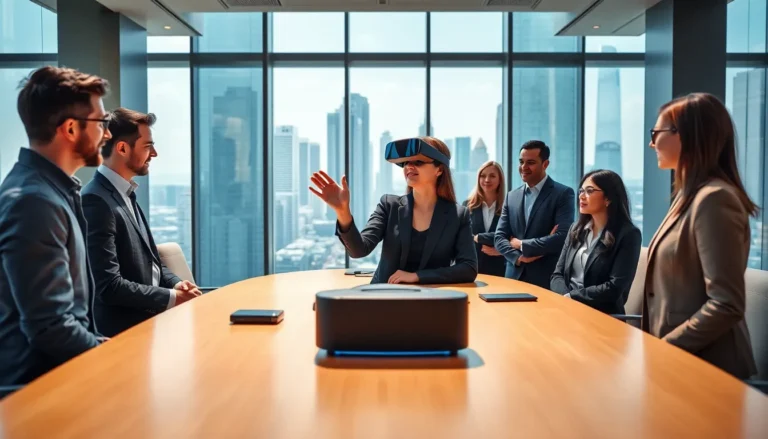Imagine walking into a space that merges the digital and physical worlds effortlessly. That’s exactly what augmented reality (AR) offers to architecture, transforming how designs are visualized and experienced. It’s like having a high-tech cloak of invisibility that reveals what’s hidden in the architectural blueprint. Want to see what that dreary empty lot can become? Just whip out that smartphone or AR headset. This vibrant blend of creativity and technology not only enhances design processes but also engages clients in an immersive experience. Let’s jump into the fascinating realm of augmented reality in architecture and explore the wonder it brings to the table.
Table of Contents
ToggleWhat Is Augmented Reality in Architecture?

At its core, augmented reality in architecture refers to the integration of digital information with the real world. Using a combination of software and hardware, AR overlays digital images, information, and models onto physical environments. Imagine pointing your device at a construction site and seeing a fully rendered building where there’s only dirt and tools. This technology uses tools like smartphones, tablets, and smart glasses to blend the virtual and physical realms, enhancing how architects and clients perceive structures before they even exist.
In architecture, AR plays a crucial role, allowing architects to visualize complex designs and capture the intricate details behind their creations. Rather than relying solely on drawings and 3D models, they can use AR to project their designs directly onto the intended site. This not only fosters creativity but also bridges communication gaps between teams and clients.
Benefits of Augmented Reality in Architectural Design
The benefits of incorporating augmented reality into architectural design are as exciting as they are numerous. Firstly, AR drastically improves visualization. Clients can step into a virtual space and experience a project before its construction. This eliminates misunderstandings, helping everyone involved grasp the final product’s look and feel.
Next on the list is improved collaboration. Architects can share immersive experiences with clients, contractors, and stakeholders, enabling real-time feedback and modifications. This leads to a more streamlined design process, reducing costly revisions late in the game.
Cost-effectiveness emerges as another major benefit. By using AR to simulate environments, architects identify potential design flaws before ground is broken. This pre-construction analysis can save significant resources, time, and effort. Also, AR enhances marketing efforts. With visually compelling virtual walkthroughs, architects can attract clients more efficiently, showing off designs in a manner that’s far more engaging than traditional catalogs.
Key Technologies Driving Augmented Reality in Architecture
Several key technologies meet at the crossroads of augmented reality and architecture, creating this revolutionary design approach. First, we have sensor technology. Devices equipped with high-precision sensors can detect their surroundings and provide accurate overlay of digital information on the physical world.
Next, computer vision plays a huge role. This technology enables machines to interpret and understand visual data from the environment, ensuring that augmented overlays appear correctly in context. Importantly, mapping and localization techniques help position the AR experience within a physical space, making interactions seamless and intuitive for users.
Also, advanced graphics processing units (GPUs) render stunning visuals in real time, ensuring that overlays are not just functional but visually captivating. Combining these elements, AR has become increasingly accessible and powerful, encouraging its adoption in modern architectural practices.
Applications of Augmented Reality in Architectural Projects
The applications of augmented reality in architectural projects are diverse and innovative. One noteworthy application is during the design phase. With AR, architects can manipulate designs interactively, allowing for on-the-fly adjustments based on client feedback. This iterative process can lead to designs that are precisely tailored to client expectations.
Also, AR comes into play during project presentations. Imagine walking potential clients through a pre-rendered 3D model projected onto the construction site, helping them visualize the completed project in its future home. It creates a tangible connection between the design and the space.
Then there’s training and education. For architecture students and professionals, AR serves as an invaluable learning tool. By immersing themselves in augmented environments, they can engage with architectural concepts hands-on, fostering deeper understanding and skill development.
Challenges and Limitations of Augmented Reality in Architecture
Even though its potential, augmented reality in architecture isn’t without challenges. Technical limitations present a significant barrier. Many AR systems require powerful hardware, restricting accessibility for smaller firms or independent architects.
Also, the user experience can occasionally falter. If the AR overlay doesn’t align perfectly with reality or lags, it disrupts the immersion and can confuse users. Training can also be an issue: architects and firms need time to adapt to this new way of working. Overcoming these hurdles involves both financial investment and commitment to ongoing education about AR technologies.
Privacy concerns could also emerge. As AR involves capturing data from the physical world, improper handling of this information can lead to security issues, a definite consideration for firms navigating this landscape.
Future Trends in Augmented Reality Architecture
Looking ahead, several exciting trends are shaping the future of augmented reality in architecture. One is the integration of artificial intelligence (AI). By combining AI with AR, architects can streamline design processes even further. Consider AI-driven applications predicting client preferences based on past projects, enhancing personalized design options.
Another trend is the rise of more intuitive user interfaces. Current AR tools often require specialized training: future developments aim to make these technologies user-friendly, enabling architects to focus on creativity rather than technical details. Collaboration among different teams will be seamless, optimizing project turnaround time.
Finally, as AR technology continues to advance, virtual reality (VR) experiences may begin merging with augmented reality. This hybridization could lead to entirely immersive design environments where clients can experience spaces from various perspectives, simulating real-life scenarios.






